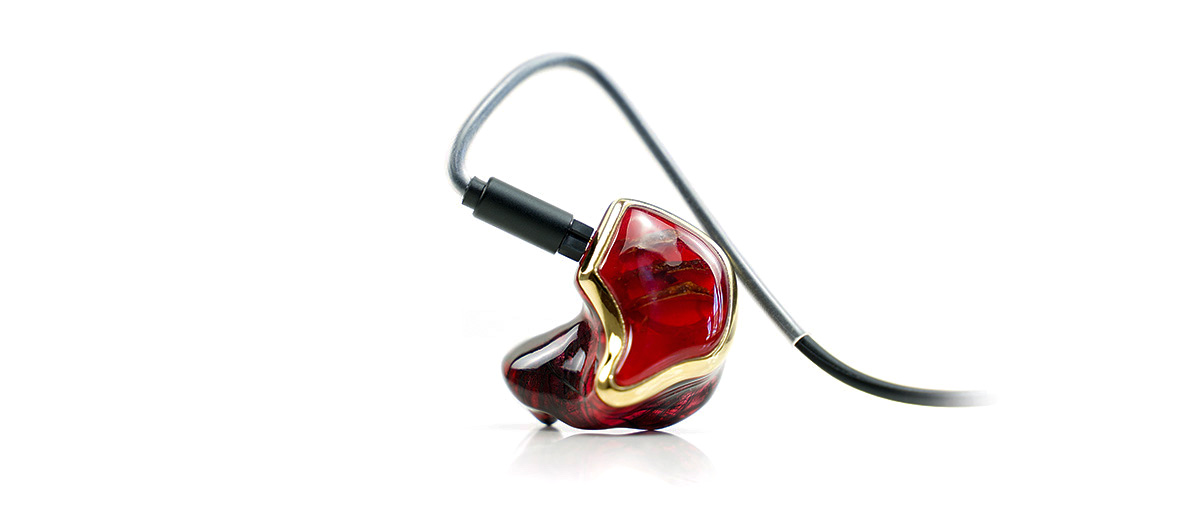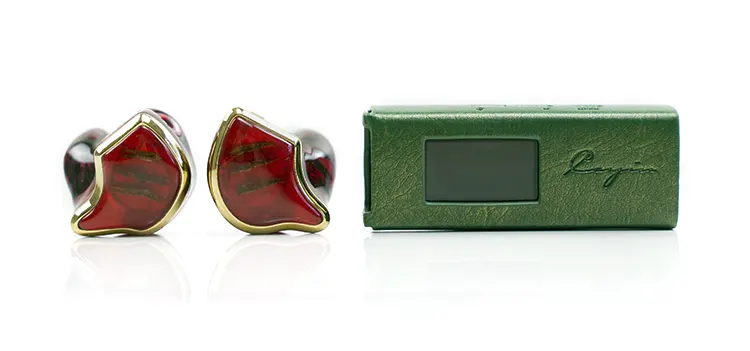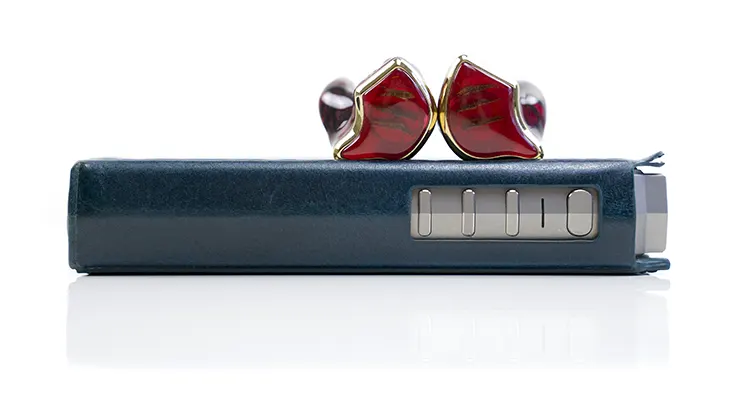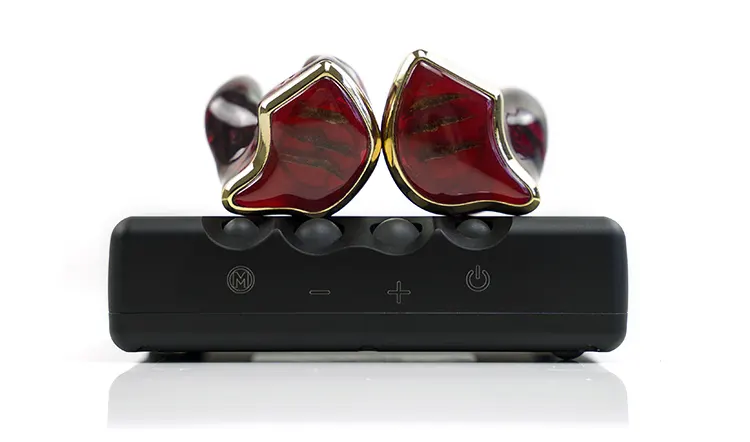Sound Impressions
The following MEST MKIII CF sound impressions were created using a mixture of the HiBy RS8, the Cayin RU7, and the Chord Electronics Mojo 2 as our main source pairings, (including amplification).
Summary
The Unique Melody MEST MKIII CF is an altogether different experience from what has come before it.
That is not to say the sound is suddenly bright and shallow sounding, it still has that reassuring bass heft and smooth delivery. Rather, it’s a far more balanced sound, less exaggerated in the extremes, and dare I say it the first MEST tuning that vocal lovers can really get into.
You could call the tuning unflappable with barely a hair out of place and a very refined and natural-sounding harmonic balance throughout. It is the type of tuning you can listen to for hours without any noticeable listening fatigue.
Previous iterations were more ‘excitable’ and had more contrast in their tonality either with more fundamental emphasis or more treble in the overtones. This created an additional emphasis on these areas but also stripped out some of the refinement and presence in the mids.
The MEST MKIII CF drops both ends by a few dB and creates a bit more bloom in the lower mids and that seems to enhance the midrange body quite nicely, especially for vocal sweetness and presence.
The slight drop in treble energy from the MKII only adds to the perception of a very natural and smooth delivery from the MEST MKIII CF.
And I say slight, as this is not a walled-off top-end courtesy of those EST drivers providing good headroom and a small peak around 5-6k from the BA drivers that give a delicate emphasis to some higher-pitching percussion.
It makes an important difference compared to something like the MEXT which is a lot softer and veiled sounding in comparison.
Bone Conduction
There is honestly very little in the way of harshness in this presentation and arguably some will call it a ‘safe tuning’ as a result.
What prevents me from agreeing with that is the bone conductor performance this time around. You can pick up on its effect on the MEST MKIII CF better than any previous MEST configuration.
I never really spoke too much before about the effect of bone conduction in the original and MKII having been undecided if they were game changers or simply the rest of the driver setup was really just that good.
This time it is a worthy observation, especially in the extreme ends of the stereo field where the layering gives you an almost tactile feeling of energy in both ears when the driver becomes active.
Notes not only benefit from the dynamic driver’s deep pitch but also offer better character and presence, even if subtly imaging out wide and behind the main instrumental focus.
Frequency Response
The MEST MKIII CF has a bit of sub-bass bias in terms of peak amplitude but it’s not as peaky and as aggressive as the MKII and starts dropping from around 50Hz onwards giving it more of a sub-bass kick compared to the likes of the BA woofers of the Maven Pro which offer a stronger mid-bass punch.
From 50Hz down to 500Hz, the MEST MKIII CF has a gentle drop for separation then a slow rise to a peak around 2-3k. It will pick up a bit of bass warmth with the lower midrange amplified a bit more compared to the MKII’s flatter equivalent.
That 1-3k peak is still south of the ideal Target response curve so you could term the midrange as relatively relaxed in its imaging with more space between you and the performer and less in your face tuning.
I tend to find that is becoming a more popular FR tuning these days on high-end IEMs with the Viking Ragnar and the Multiverse Mentor two recent examples of keeping things back a bit.
From 3-5k you get a bit of a dip but it’s not very noticeable for subjective listening purposes. It might take a little bit of sting out of any potential treble overtones on percussion by reducing the energy a little there but that’s about it.
The MEST MKIII CF detail and resolution are some of the strong points here so I would not worry about vocal clarity and general instrumental separation throughout this range.
From about 6k onwards the MEST MKIII CF treble emphasis is a few dB lower than the MKII tuning so the amount of contrast in the timbre is comparatively reduced. You could argue it’s a slightly darker delivery but I find the balance to be spot on with a slightly softer touch and still offering excellent headroom from those EST drivers.
Timbre
This is probably the most appealing aspect for my tired ears at this stage in my reviewing career.
This is a very natural timbre veering to the slightly sweet and euphonic but overall, a beautiful harmonic balance. Nothing is overly shouty with too much contrast or heavily weighted with blunted edges.
Especially for higher-pitching vocals from brightly mixed audio recordings that I tend to use as test cases to see if I can stress out a monitor’s treble performance.
The MEST MKIII CF remained unperturbed with a very liquid tone and just a light spattering of sparkle to give gentler notes a subtle lift and enough emphasis to be noticed without dominating.
The weight from the fundamental is more nuanced now compared to the MKII. It reaches just as deep but not as exaggerated. Instead, you get a fuller-sounding lower mids to compensate with a nice balance from the sub-bass power when required to give those instruments some needed gravitas and presence.
Vocals are where the MEST MKIII CF also pushes ahead of the MKII with a smoother harmonic balance and more body. Backing vocals also sound more substantial with a more realistic level of decay.
Staging & Dynamics
Depth and width are excellent here though the presence and aggression are not as exaggerated. Some might define the imaging placement as more relaxed in general and granted the MEST MKIII CF is not an intimate performer, instead giving you a very balanced presentation throughout.
The degree of noticeable space and separation has improved with vocal imaging benefitting the most despite the FR curve being somewhat south of the ideal target response.
It is quite noticeable how much easier it is to focus on the vocal presence compared to the previous models in this range. Even when the bass cues become strong or energetic in their delivery they never seem to be overwhelmed.
Of course, if you enjoyed the higher levels of treble energy or contrast in your music from the MKI and MKII you might be yearning for a bit more sparkle also from the MEST MKIII CF. That might be the one area you will need to turn to a bit of EQ if you want your percussion to have a bit more fizz and bite.
Source pairings did shift my focus a bit when listening to the MEST MKIII CF. The Mojo 2 was perhaps the most holographic of the pairings. Its neutral tone does help significantly in creating a cleaner more focused soundstage whereas the likes of the FiiO M15s shifted the attention to the lows and vocal richness and lopped off a bit of height and air in the process.
Synergy
Efficiency
The Unique Melody MEST MKIII CF is rated at 14Ω and 104 dB @1kHz 1Vrms with a default balanced cable termination using a 4.4mm Pentaconn plug, (though you can check out with single-ended if you prefer).
This is not a terribly hard monitor to drive with all our tested sources pushing it comfortably in a low gain mode such as the HiBy RS8 or in a low volume setting in high gain such as the Cayin RU7.
Going single-ended with the Mojo 2 also presented no issues with sounding clean, dynamic, and without requiring too much of a boost in volume. You should not be picking up any background hiss or noise from modern DAPs and dongles with the MEST MKIII CF.
One psychoacoustic knock-on effect from its more balanced and controlled tuning when compared to the MKII for example, was a slight tendency to boost the volume even though it didn’t really need it.
Coming off a more bass-intense monitor such as it or the slightly more sensitive Maven Pro can make you want to boost the loudness to compensate. However, I found the opposite with the MEXT, where the MEST MKIII CF sounded punchier and more dynamic when the volume matched.
Pairing Preferences
I tested 4 DAPs ranging including 2 Cayin models, the N8ii and the N7, as well as the FiiO M15S, and the HiBy RS8. Added to that were the Cayin RU7 dongle and the Mojo 2, the latter of which was the standout performer with the MEST MKIII CF.
Before I explain why, just as a general preference from testing the above, I did find I preferred a source that either added some good dynamics on the MEST MKIII CF lows or produced an airy clean tone with loads of separation and depth to the soundstage. I felt either quality teased out the best in the monitor’s tuning.
Chord Electronics Mojo 2
The Mojo 2 hit both of those preference categories with a vivid vocal presence, absorbing holographic qualities to the soundstage, and absolutely excellent dynamic range, particularly the response and definitions of the sub-bass.
Bear in mind that this is a single-ended amplifier so you do not need to go balanced to get the best sound out of the MEST MKIII CF. It was also our cheapest option on the table if you do not count your smartphone or iOS device into the costs.
HiBy RS8
A close second for me was the RS8. Again, it retains a very natural quality to the tonal balance of the MEST MKIII CF but of the remaining DAPs, I felt it had a slightly more neutral sound signature that helped shape and define the notes a bit better.
The additional Vrms from the Turbo Boost also give the lows a bit of a lift while adding some improved staging depth to the MEST MKIII CF performance.
FiiO M15s
The M15S does well in fattening the lows and enriching the vocal performance of the MEST MKIII CF, particularly with the 2nd harmonic order feature turned on. It doesn’t have the space or the same headroom as the aforementioned Mojo 2 and RS8 and will present a more intimate bottom-weight staging quality.
You might want to keep the 2nd harmonic order option turned off if you fancy a little more contrast in the timbre of this pairing. It does make a noticeable difference.
I would also recommend turning on the All-to-DSD option on the M15S as without it, the soundstage sounds flat and lifeless.
Cayin N8ii & N7
The Cayin’s brought in some interesting results and which one you prefer and how it affects your enjoyment of this pairing will depend on the active DSD upsampling mode active on the N7 and the timbre/operational mode on the N8ii.
The N8ii is going to deliver the stronger vocal presence and the more liquid-like tone of the two DAPs. The N7 does really well for separation and staging width but its more neutral midrange imaging means vocals, though smooth, lack the same connection as the N8ii.
The only drawback from the N8ii pairing was my perception of a slightly softer mid-bass punch with this pairing compared to the N7’s firmer delivery.
The N7 upsampled to DSD256 or DSD512, though not as drastic a change as the RU7 upsampling equivalent, will bring in a cleaner treble and some enhanced midrange clarity. Keeping it to DSD64 allows the low-end to take priority on the MEST MKIII CF with a weightier more rounded tonal quality.





